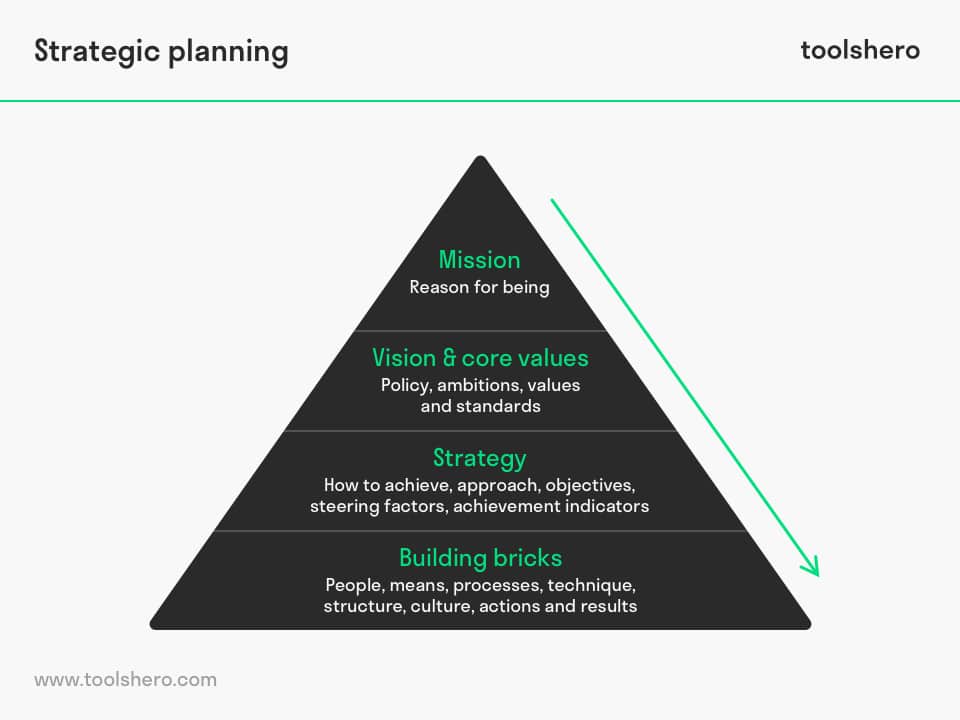Strategic Planning explained

Strategic Planning: this article explains Strategic Planning in a practical way. The article starts with a general definition and the meaning of strategic planning in an organisational context, followed by information about the process and different tools to use in this proces. Enjoy reading!
What is Strategic Planning?
Which direction does an organization take and why?
A Strategic Planning determines the course of an organization and provides clarity about the associated decision making process. It is focused on the allocation of means, capital and people in order to implement this course. By answering at least one of the three questions below, the company will have a clear idea about its strategy:
- What do we do?
- For whom do we do it?
- How do we Excel and what do we excel in?
Long term
Many organizations view strategic planning as a process to define their long term direction. This time span may take five years but may be extended up to 20 years.
It is crucial for organizations to determine their current position first and then consider how they can achieve the desired situation. Such an approach is referred to as the actual / target situation. A strategic plan for the future is linked to the intended result.
Strategic Planning is about mission, vision and values
Many organizations start by drawing up a vision and mission statement and use these as the basis for the formulation of goals and objectives. There is a distinct difference between mission and vision:
Mission statement
A mission statement defines the reason why an organization exists and how it will survive. A mission statement can be drawn up for any given organization. It may be designed for the long term or for each phase of the organizational development (short term).
The purpose of the time-line of a mission is to pursue the organizational objectives and adjust them if necessary. The mission statement may help employees to achieve well-defined objectives provided these are SMART Goals (Specific, Measurable, Attainable, Realistic and Timely).
Vision statement
The vision statement is the strategic part which defines the intended future state of an organization. The vision statement describes the fundamental and specific objectives and these will provide a framework for the decision-making process. The term ‘vision’ targets the long term for which an organization creates a picture of the future.
Values
Values or Core Values are embedded in the beliefs that a company shares with all interested parties. These values drive the desired culture of an organization and influence its priority setting.

Figure 1 – Strategic Planning elements
Strategic planning process
A mission statement can be seen as a basic concept to achieve the vision, and this must be in agreement with an organization’s core values. These core values have a direct influence on the success of the organization. But what should be written first, the mission statement or the vision statement? This depends on a number of factors.
For a start-up business or a new product the vision is the guiding principle, in which the rest forms part of strategic planning. In an established company, the mission statement accompanies the vision and the rest of the strategic plan. It is crucial that, in addition to fundamental goals, the current situation of the organization is taken into consideration.
Internal means and strengths and/or weaknesses must be taken into consideration as well as external circumstances (opportunities and/or threats) and the course that is to be adopted. It is very important that the desired result is clear from the onset.
Element of Corporate Culture
In order to work effectively, a vision must be completely incorporated in the organizational culture. Managers can fall back on the vision and communicate this to the employees.
Managers can be exemplary role models with respect to the intended vision and core values and create short-term goals. The mission statement must be evaluated continuously both internally and externally, in which the internal evaluation should be aimed at how members interpret the mission statement within the organization.
Different levels
Strategic planning can be translated into objectives that need to be carried out within the different hierarchies of an organization. The Top Rank Objectives (TROs) or strategic objectives are the basis for the Second Rank or tactical objectives within an organization.
In turn, these tactical objectives are the basis for the Third Rank Objectives or operational objectives. For each hierarchical level it is important to consider ‘how’ or in which way the objective must be executed without losing sight of the main objective. This is why the question ‘why are we doing this’ must be asked.
In this manner, all levels in the organization will be on the same page and as a result, everybody will work with the mission statement in mind.
Strategic Planning tools
Several business analysis techniques can be used for strategic planning. Examples are the SWOT Analysis (Strengths, Weaknesses, Opportunities en Threats), DESTEP-analysis (Demographic, Economic, Social, Technological, Ecological and Political aspects), STEER-analysis (Socio-cultural, Technological, Economic, Ecological en Regulatory factors), and EPISTLE (Environmental, Political, Information, Social , Technological, Legal and Economic aspects).
Core activity
Strategic Planning is a very important core activity in both the profit and non-profit sectors and is used both formally and informally. Strategic Planning, Scenario Planning and decision-making processes must end with concrete objectives and a clear phased plan so that the intended objectives can be realized.
Strategic Planning is always about the desired end results, long-term planning, policy, goals and objectives, strategies, core values, tactics and concrete actions.
It’s Your Turn
What do you think? How do you apply Strategic Planning in today’s modern businesses? Do you recognize the practical explanation or do you have more additions? What are your success factors for good Strategic Planning?
Share your experience and knowledge in the comments box below.
More information
- Rothaermel, F. T. (2012). Strategic Management: Concepts and Cases. McGraw-Hill.
- Johnson, G, Scholes and K. Whittington, R. (2008). Exploring Corporate Strategy. Prentice Hall.
- Blatstein, I.M. (2012). Strategic Planning: Predicting or Shaping the Future? Organization Development Journal, Vol. 30 Issues 2, pp. 32.
How to cite this article:
Van Vliet, V. (2012). Strategic Planning. Retrieved [insert date] from Toolshero: https://www.toolshero.com/strategy/strategic-planning/
Original publication date: 01/04/2012 | Last update: 10/24/2023
Add a link to this page on your website:
<a href=”https://www.toolshero.com/strategy/strategic-planning/”>Toolshero: Strategic Planning</a>













5 responses to “Strategic Planning explained”
Thank you so much for making this material available. it was informative
You are welcome. If you have any suggestions, please let us know. Kind regards, Vincent
Good and nice, it is so helpful.
Thank you, Thoughtful words
Very informative, guiding tool in business every succes , a good tool for anyone in business.